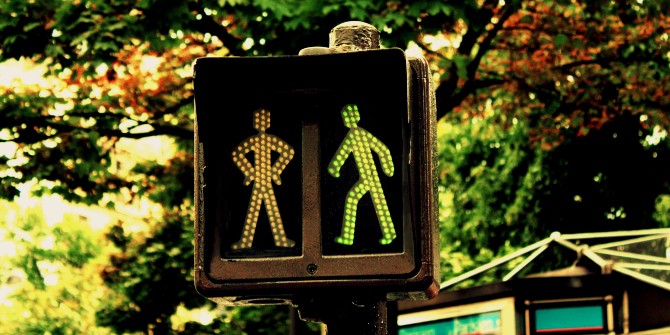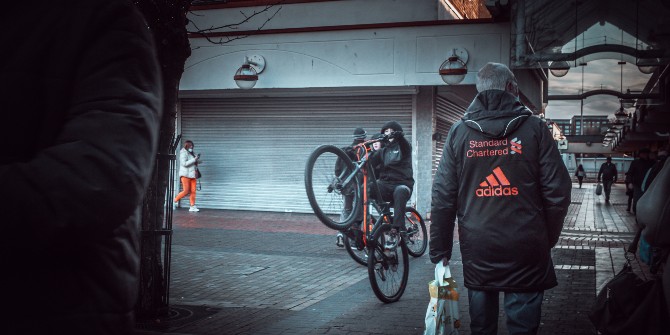London’s strong position as a global city will remain post-pandemic, says Mark Kleinman (King’s College London). But the negative impact on key sectors including arts and culture, hospitality and tourism present significant short-term challenges for the capital.
Along with New York, London is in a category of its own: for 30 years, we have congratulated ourselves on its status as a global city. London’s global city success has however made it particularly vulnerable to COVID-19 – not only in the immediate sense of London being a centre for international travel, but also because of the economic importance of mutually dependent industries such as business, hospitality, arts and culture and tourism. The biggest impact of the pandemic has been on the very complex ecosystem of the Central Business District, or Central Activities Zone (CAZ) as we call it in London. Historically, the CAZ has attracted people to its retail, leisure and cultural offer, as well as its concentration of professional and other service employment. Customers are now returning to shops, but the retail sector will be impacted by a likely long-term re-balancing between online and in-person activity. Arts and culture may take longer to see audiences return to pre-pandemic levels, and London needs to think about how to keep the sector vibrant and healthy through what could be more than one cycle of reduced audiences.
London’s position within the UK is not going to be seriously challenged
Other big questions remain. Will there be as many business meetings as there were before? How often will professionals and white-collar workers work from the office rather than from home? The answers to these questions are not clear, and there will doubtless be a period – perhaps prolonged – of experiment and of adjustment, by both firms and workers. Nonetheless, I expect London’s economy to recover fairly quickly, and to continue to maintain the role it has at present, as one of only two ‘alpha++’ global cities.
London’s position within the UK is not going to be seriously challenged. The government struggles to explain exactly what its commitment to ‘levelling up’ means in practice. But it is clear that there is (at present anyway) no attempt to create comparable alternative centres of economic power in the UK. Rather, there is a policy of distributing additional public funding fairly thinly across a number of places outside London, with an emphasis on towns rather than cities, and on investments that “improve everyday life across the UK”. This is an entirely defensible policy stance, but it is unlikely to make a radical difference to the structure of the UK economy in five years time. In contrast, while he was chancellor, George Osborne aimed to make the northern cities – and in particular Greater Manchester – a “powerhouse for our economy again”. Further back, in 2002, the Labour government under Tony Blair committed to a cross-Whitehall long-term target of making “sustainable improvements in the economic performance of all English regions by 2008, and over the long term [reducing] the persistent gap in growth rates between the regions”.

We are not seeing a similar effort now. This suggests that in practice, if not in rhetoric, the government is wedded to a default model in which the UK as a whole remains dependent on the economic success of ‘London’ – in practice a wider economic region comprising the Greater South East – for both leading UK economic performance and contributing a major redistributive fiscal contribution. This isn’t good either for London or for the rest of the UK.
While London will remain at the apex of the global urban hierarchy, it will have to work harder to maintain its relative position
What about the locational impact of the pandemic? Won’t some firms and households choose to relocate where more and cheaper space is possible? Up to a point, and such relocations as do happen are likely to be to other growth poles within the Greater South East mega-region, such as Oxford, Brighton, Cambridge and so on. One important effect of High Speed 2 will be to further expand the boundaries of the London region – the Greater South East – by reducing the travel times between other growth nodes and central London.
Post-pandemic, the pattern of commuting from suburbs and dormitory towns to central London may well change. But in England, this is unlikely to lead to Los Angeles-type urban sprawl. One consequence of travelling into the office less can be that the labour market expands, because workers can live further away. A more complex pattern of residence, workplace and mobility may emerge, in a more polycentric mega-region.
These economic changes, and the population shifts accompanying them will have electoral consequences in the southern half of England, some early signs of which were seen in the May 2021 local elections. In those elections, there was evidence of some traditionally Conservative areas moving to the Greens, Labour and Liberal Democrats. Labour won the metro mayor contests in Cambridgeshire and Peterborough, and in the West of England, while previously Conservative-controlled Oxfordshire and Cambridgeshire county councils are now run by non-Conservative coalitions. These are small cracks in the ‘Blue Wall’ compared with the significant gaps which have emerged in the formerly Labour ‘Red Wall’ areas in the North and Midlands – but these small cracks could expand.
While London will remain at the apex of the global urban hierarchy, it will have to work harder to maintain its relative position. Public health, safety and wellbeing are going to become important, selling points for global cities, alongside established metrics such as international connectivity, talent pool, quality of life and ease of doing business. To rise to these new challenges, London will need the strong support of the UK government as well as leadership from the Mayor, boroughs and the London business community.
This post represents the views of the author and not those of the COVID-19 blog, nor LSE. It is based on Mark Kleinman’s contribution to Getting London Growing Again?, an open seminar hosted by LSE Regional and Urban Planning Studies.





